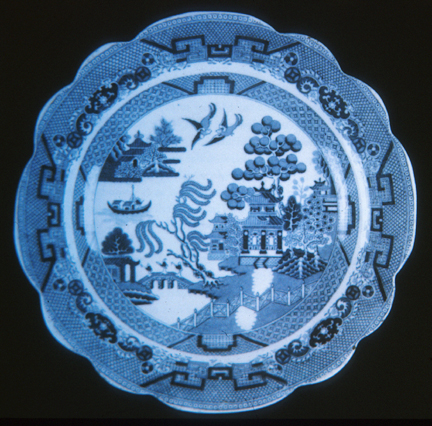
Ironstone Plate with 'Willow' Design, Belle Vue Pottery, English 1826 CE
ART 198 - HISTORY OF WORLD CERAMICS
| Ironstone was a type of stoneware introduced in England early in the 19th century by Staffordshire potters who sought to develop a porcelain substitute that could be mass-produced. The result of their experiments was a dense, hard, durable stoneware that came to be known by several names-e.g., semiporcelain, opaque porcelain, English porcelain, stone china, new stone-all of which were used to describe essentially the same product. The first successful manufacture of ironstone was achieved in 1800 by William Turner of the Lane End potteries at Longton, Staffordshire. In 1805 Turner sold his patent to Josiah Spode the Second, Stoke-upon-Trent, who called his bluish gray ceramic products stone china and new stone. The wares, usually service pieces and vases based on Oriental shapes, were most often decorated with painted Chinese and Japanese motifs, some of which were executed by transfer printing. Belle Vue was another factory which produced ironstone pottery. This example features the famous 'Willow' pattern, introduced by Thomas Turner in 1780. The popular pattern depicts a Chinese story and includes a willow tree, a pair of doves, a pavilion and a lake with three Chinese people standing on the bridge. The pattern was produced not by handpainting, but by a transfer process invented by Josiah Spode (the younger) in 1784. Transfer printing is an off-shoot of the engraving process. A paper 'pull' is taken from an engraved and inked (with cobalt) copper plate. This 'pull' was then transferred and applied to the dry porcelain or ironstone surface, and would be affixed during the bisque process. A clear glaze was then applied and fired over this image. From a single plate, innumerable copies could be made. The invention and application of the transfer process meant that now every step, from forming to decorating, could be done by machines, and hand decorating became another endangered industry. | Ironstone Plate with 'Willow' Design, Belle Vue Pottery, English 1826 CE |
|
|